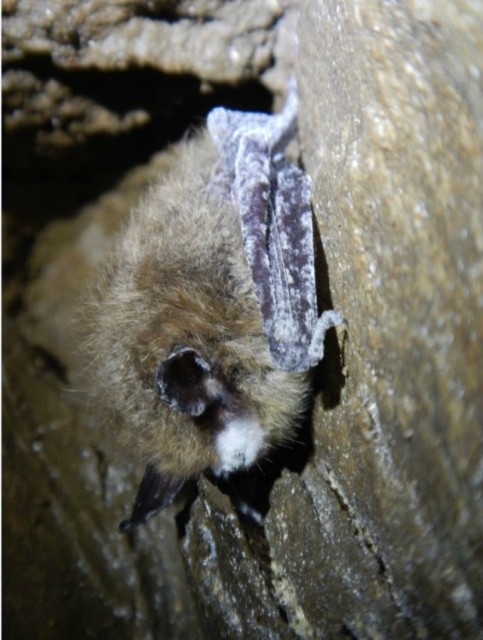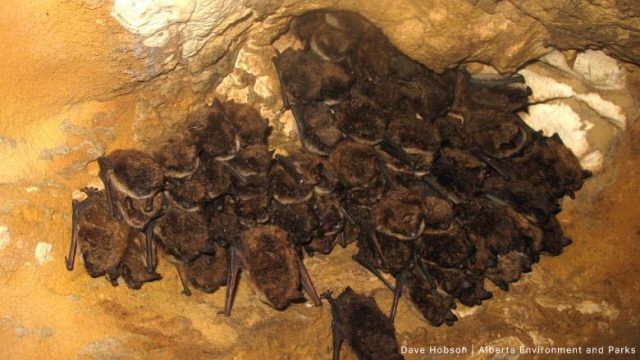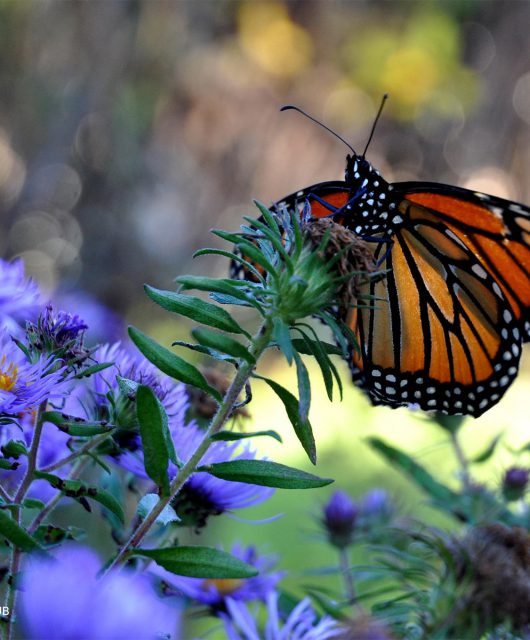Could Probiotics Slow the Spread of White-nose Syndrome in Western Canada?
Alberta researchers are stepping up to the plate in the fight against a deadly fungus that has decimated populations of Little Brown Myotis, Northern Myotis and Tri-colored Bat in eastern Canada and that is now hitting the Prairies. Targeting the Little Brown Myotis, the innovative treatment involves spraying a probiotic cocktail into bat houses when the endangered mammals are out and about foraging for insects. The probiotic is a mix of naturally occurring beneficial bacteria, designed to coat the bats’ wings when they return home. This could help prevent the deadly fungus from penetrating though their skin, and they may even be able to transfer the probiotic to other bats.
Stopping the Spread

The fungus that causes White-nose Syndrome (WNS) was first detected in Canada in 2009, with the first occurrence in Alberta in 2022 near Dinosaur Provincial Park. The infected bats literally had holes in their wings from the fungus. They were also seriously malnourished. Conservationists had to act quickly to monitor and mitigate the situation. Most Canadian bats give birth to only one pup per year and thus have a very slow population growth. Infected bats are not likely able to raise pups, so the situation is very serious. The disease has already ravaged bat populations in eastern Canada and while every effort was being made to save the affected species, new strategies were required to slow the spread in the west. Altogether, WNS has already killed upwards of ten million bats across eastern North America.
The Good Bacteria

While researchers in the United States are working to develop a vaccine for the disease, in Alberta, trials of a probiotic treatment are underway. The mixture was developed by scientists at the Wildlife Conservation Society Canada, McMaster University and Thompson Rivers University. It has shown up in areas where it was not applied, demonstrating how bats may be transferring it to other bats. The probiotic has also been tested in BC since 2018 at maternity roosts. Government-led trials are still ongoing, but hope prevails that these good bacteria will provide protection against the spread of the fungus which causes the disease.
Creature Comforts

When bats are in hibernation, the deadly fungus is at its worst. It thrives in cold, moist conditions and seeps into a bat’s wings, undetected by their immune systems. This wakes the mammals up when food supplies are not available and thereby depletes their fat reserves. The fungus that causes the disease was first discovered in the United States in 2006 and in Canada in 2009. It is finally receding in Atlantic Canada, with some bats showing signs of resistance to the fungus, albeit leaving behind extremely low bat populations. Meanwhile, researchers in the United States have found a relationship between the way the fungus works and the way human lung cancers survive and grow, leading to drug trials outlined in the July 2024 issue of Science Daily.
Homes Away from Home

Bats will naturally roost in caves and tree cavities but as these wild spaces become harder and harder to find, they need other housing options. Bat boxes can help provide important habitat for mammals that have lost their natural roosts to development or have been evicted from human homes. CWF and our partners have been busy helping Canadians learn what kind of bat houses and placements work best in different areas of the country. The results of our National Bat Box Study provide several important tips:
- Install boxes on buildings and place them at least three metres from the ground.
- Multiple boxes with a mix of sun and shade are ideal.
- Larger boxes with at least three chambers are most successful.
- Vents on the front and sides reduce the chance of lethal overheating inside the bat house.
Worth the Effort
Bats save the Canadian agricultural industry millions each year by consuming insects and reducing the need for pest control. Canadian bats can catch hundreds of insects in just one hour. In fact, bats typically consume between 30 to 50 per cent of their body weight in insects in a single night; a pregnant female can consume up to 100 per cent of her body weight each night. Having a healthy colony of bats can protect gardens and crops from damage and pests. In fact, their value to the economy is estimated to be at least $30 million.
To learn more about these important and often misunderstood mammals, visit HelptheBats.ca.






1 comment
Good Afternoon,
I run a land guardians program in the Nicola Valley of BC, Nlaka/pamux territory. we have a 3 year running ultrasonicARU bat monitoring program/ network across the valley, understanding roost/ habernacle behaviour across different elevational strata and roosting habitat stratum (cave/karst, natural wood, human structure/isolated/heated/other). We are finding high diversity, 12/14 species of bats and lots of activity, 9 endangered species being recorded as well. We’d like to expand our programming into proactive mitiagtion, building roosts, engageing youth and other community segments, even perhaps running a pilot of the “godd bacteria” innoculaum that is being pilotted to combat white nosed syndrom? WOuld love to connect with a bat biologist that works in BC as it is a focus of our growing programming in the valley and territory! thanks – Alex LaForce PS: we work a lot with your fisheries biologists, Betty Rebalato, etc and did the Clapperton Creek barrier remediation on our reserve with CWF previous years and always looking forward to more collaboration!